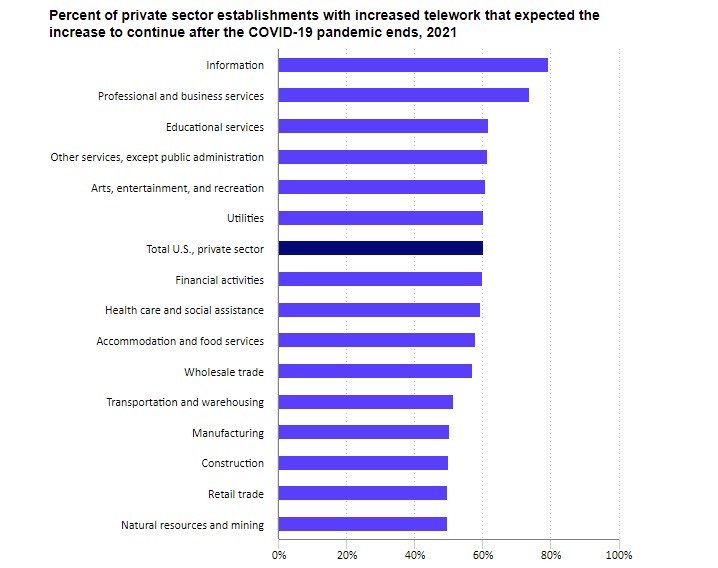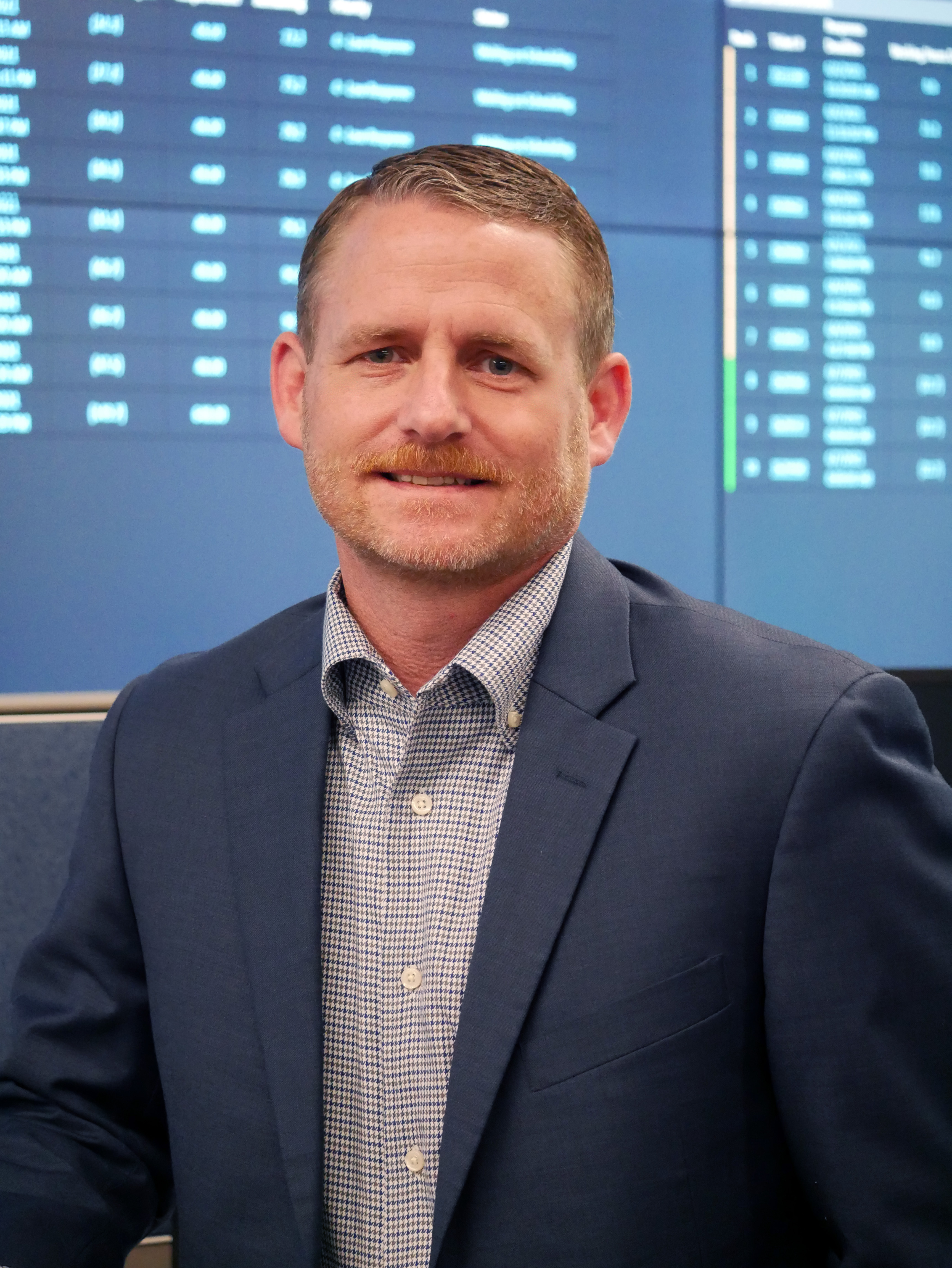IN-DEPTH |
Hybrid and remote work models, while nowhere near the levels reached during the height of the pandemic, have arguably become a permanent fixture of American life, including in Springfield.
COVID-19 forced a lot of people to work from home. For some employees and industries, it stuck, even as pandemic restrictions fizzled.
“I don’t see it going away,” said Vicki Pratt, the senior vice president of economic development at the Springfield Area Chamber of Commerce.
National trends reflected in some sectors of Springfield’s workforce
For many, working remotely isn’t an option, or at least more limited or challenging. Certain industries require their staff to be in person to maintain operations. Some have found a hybrid schedule works well. Others find working from home full time just makes sense.
The Bureau of Labor Statistics (BLS) examined data from the start of the pandemic to 2021 to see which industries have increased telework, and which ones expected that increase to continue even after the pandemic.
Why Care? Remote work was most prevalent in a select few professions and industries during the pandemic. Local consensus and national data indicate that it’s here to stay, has the potential to spread to other sectors of the economy, impacts real estate and gives opportunities to small businesses and anyone seeking to find a better work-life balance.
An average of 60 percent of private sector establishments expected telework to increase beyond the pandemic, with the information, educational, professional and business service sectors anticipating the remote work trends to continue more so than other industries.
But even among sectors that saw very little telework growth since the onset of COVID-19, including accommodation and food services, retail trade and natural resources and mining, many see hybrid and remote work models as a part of their future as well.

Some of Springfield’s information service companies align similarly with national trends, including Jack Henry and Associates and JMARK. Both organizations have employees across the country but are headquartered in Southwest Missouri. Both are also IT service providers, but specialize in different fields and serve different clientele.
JMARK is a mid-size business, with 120 employees companywide, the majority of which are concentrated near their Springfield HQ. Jack Henry employs roughly 7,000 people across the country, with about 2,000 working in Southwest Missouri, both in Springfield and at their main offices in Monett.

For JMARK and Jack Henry, telework was introduced into their operations before the pandemic, but COVID played a role in growing their hybrid and remote work models.
Holly Novak, the chief people officer at Jack Henry, said about 30 percent of their staff was remote before the pandemic hit.
“[That] made it honestly easy for us to transition really quickly when COVID happened because we already had the infrastructure in place to just kind of push a button and everybody went remote,” Novak said.
Today, almost three years after COVID-19 was declared a pandemic, that number is 77 percent. Novak doesn’t see a push to return to the office any time soon, either.
“I feel like we're going to have that remote posture for a very long time in the future,” she said.
During the height of the pandemic, many telework policies were in place in order to comply with local mandates or to prevent the spread of COVID-19. Today, the reasonings behind remote work have shifted.
Flexibility top of mind in telework policies

The primary reason at Jack Henry is flexibility, according to Novak. Both flexibility for families, who may be limited by the child care shortage, and with time that would otherwise be spent driving to and from their offices, among other needs of the employees.
Having that flexibility has helped Jack Henry grapple with another shortage facing businesses in a post-COVID world: labor.
“We’ve always been really intentional about the purpose of flexibility when we’re doing talent attraction and retention,” Novak said. “That’s really important to a lot of people.”
That’s not to say they haven’t felt the sting of the talent shortage.
“We have definitely felt [it] just like everybody else, especially related to technical talent,” Novak said. “…having a remote posture was definitely a differentiator for us before COVID. It became less of a differentiator, obviously, during COVID, but now I think it’s becoming more of it again where a lot of companies are requiring people to come back into the office and we’re still keeping the remote posture.”
While some return to offices, there's a new normal in hybrid
Even as remote work has become common practice among some industries and professions, it’s noteworthy to point out that return-to-the-office requirements, often for a set amount of days a week, continues to happen as well.
Corporate Starbucks employees were recently required to return to the office at least three days a week. Disney employees will soon have to work in the office four days a week.
Even some House Republicans want federal employees to return to the office; Rep. James Comer (R-Ky.) recently introduced a bill known as “SHOW UP” a.k.a. The Stopping Home Office Work’s Unproductive Problems Act.
But for Jack Henry and JMARK, they haven’t noticed any loss in productivity since adopting hybrid and remote work models.
Thomas Douglas, the CEO of JMARK and author of the book “Adapt or Die,” attributed their employees’ success in working remotely to the company’s culture.

“If you have a great culture, then you don't have to worry about productivity at home because people are committed to doing good work,” he said.
On any given day, Douglas estimated that anywhere from 40 to 60 employees are in their Springfield offices, which is home to about 80 of their 120-person workforce.
While not operating quite as remotely as Jack Henry, JMARK emphasizes similar values when it comes to allowing employees to create hybrid schedules that work for them. They, too, had already embraced a hybrid model prior to the pandemic.
While Douglas was grateful that they were able to adapt and continue working remotely during COVID, he attributes the early shift to a flood that happened in their building several years ago, which essentially forced them to move out of their offices for a period of time.
“But because of that, it put a business continuity plan in place for our organization that facilitated a quick move during the pandemic that made it pretty seamless and easy for us,” Douglas said.
Since then, their reasons for continuing remote and hybrid schedules have changed. Flexibility and efficiency have become his employees’ biggest factors when choosing to work from home. He said that cutting down on how much time employees spend commuting allows them to spend more time getting other things done in their life.
Remote work has been inevitable since employees first began considering a work-life balance
Pratt said that, in speaking with member businesses of the Chamber of Commerce, she has found many employers in the Springfield area continue to employ hybrid work models, and they feel it helps employees strike a better work-life balance.
Pratt, who has lived in nine states and worked in economic development across the country, recalled seeing early indicators of this shift in the early 2000s, when workers were beginning to consider putting so much of their focus and energy solely on work.
“The baby boomer generation had no concept of a work-life balance, you organized your life around your job,” Pratt said. “Gen X began to look at it through a little different lens, but still pretty much followed ‘you find a job, and you manage your life around that.’ But as we progressed from there, it became pretty clear that having a work-life balance has risen in its degree of importance as a tool to recruit and retain talent.”
Pratt, a baby boomer herself, is both amused and understanding of why finding a work-balance has become a priority of today’s workforce.
“I'm acutely aware of the importance and, frankly, wonder how could we have been so foolish as to not recognize the value of that,” she said.

Telework impacts small businesses, real estate
In conversations Pratt has had with small businesses, particularly those that work in real estate and insurance, telework has provided an opportunity to cut costs.
“They’ve given up that office space and all of their agents, all of their brokers are working from home,” Pratt said. “Rent, utilities, insurance for the building. All of those costs go away.”
The reduction or outright ditching of office space was felt across not just small businesses, however, but all establishments that were able to embrace the telework model.
“Telework was also associated with reductions in workplace square footage and relocation: the share of establishments that increased telework was larger among establishments that reduced square footage or relocated during the pandemic,” a March 2022 Labor Review from the BLS reads.
While Jack Henry is considering consolidating some of their office spaces going forward, according to Novak, they don’t intend to get rid of them completely, so they can still provide a workspace when necessary to bring staff together and for those that prefer to work in-person.

Remote work continues to play a significant role at MSU, for students and staff
Prior to the pandemic, online classes were already becoming more common. COVID-19 forced Missouri State University to lean into what they learned over the previous decade or so of online education.
The implementation of virtual models has been a multi-faceted challenge for MSU and colleges across the country, as they’ve not only had to attract and retain faculty and staff, but students as well.
MSU has had to grapple with an enrollment decline and competition to maintain a qualified, diverse and full-staffed workforce, according to Shawn Wahl, the dean of the Judith Enyeart Reynolds College of Arts and Letters.
“We’ve done everything that we can do to manage or minimize enrollment decline, and it’s been tough for public and private institutions across the world,” Wahl said. “…We have endured some of that, and I think that [with] the academic realignment and innovation that we’re currently engaged in for the next fiscal year and future fiscal years at the university, we’re in a much better, stable place than many institutions across the nation.”

To combat these challenges, they’ve expanded their dual credit offerings, sought to become more agile, accessible and affordable, and continued to embrace telework even after the height of the pandemic.
Referred to as “employee flex time,” MSU has sought to become more flexible with faculty and staff, and allow periods of time for them to work remotely as determined by their manager on a case-by-case basis.
Some non-tenured faculty that help both create and teach online programs have opportunities to work entirely remotely. Offering telework in their job openings has helped them fill non-faculty positions, including IT professionals and accountants, who they’ve had an especially difficult time recruiting and retaining. Academic advisors in the College of Business now have the option to work from home up to two days a week.
They’ve also sought to expand online opportunities for students, both in their graduate programs, which have actually seen enrollment increases, and for undergraduates. Online classes give students who are unable to be on campus or have full-time and part-time jobs the ability and flexibility to further their education.
Even though the university continues to adapt to an increasingly virtual environment, Wahl emphasized that MSU still had plenty of jobs that could not be done virtually, particularly instructors of laboratories and student-facing staff and administrators.
“We’re positioning the university for the next five or more years,” Wahl said. “We really pay attention to things like remote work, things like having an academic program that might be partially online and the other half face-to-face. We’re definitely embracing those opportunities.”

It will be tedious and expensive to start gathering data on Springfield’s remote workforce
Until more local data on the remote workforce in Springfield is gathered, it’s difficult to assess how closely the city aligns with national figures in the changing landscape.
But Pratt has plans to do just that. In her strategic five-year plan, she hopes to do a “deep dive” labor analysis of the workforce in Springfield’s geographic region.
“We don’t know what we don’t know,” she said. “And I think not knowing is going to come back to hurt us.”
In the past, they have tracked labor participation and employment rates, commutation patterns and housing needs, but the pandemic has forced them to take other factors into consideration.
“That data, while it certainly isn’t irrelevant, it’s not the whole picture anymore,” Pratt said. “It’s not even close to the whole picture anymore. So figuring out how we get the whole picture becomes a challenge.”
While Pratt has plans to take on that challenge, she said gathering this data, especially when it comes to tracking remote workers, will be very “tedious and expensive.”
Regardless, Pratt is convinced that whatever results she finds will indicate remote work is here to stay.
In “Adapt or Die,” Douglas emphasized how major shifts in technology transformation don’t shift back, and thus he sees telework as a permanent part of the work environment moving forward.
“You don’t have people who get up in the morning and say, ‘Man, I wish I could ride a horse to work today,’” Douglas said. “They jump in their car and they’re happy that they can jump in their car because it’s warm and it’s predictable.
“…The same is true when it comes to technology. Things have shifted in a hybrid work environment. And while it shifted to the extreme, and anytime it goes to the extreme, it comes back to balance. But I think that there was always going to be a hybrid work environment, that is going to drive the economy and we're seeing it across the country.”

